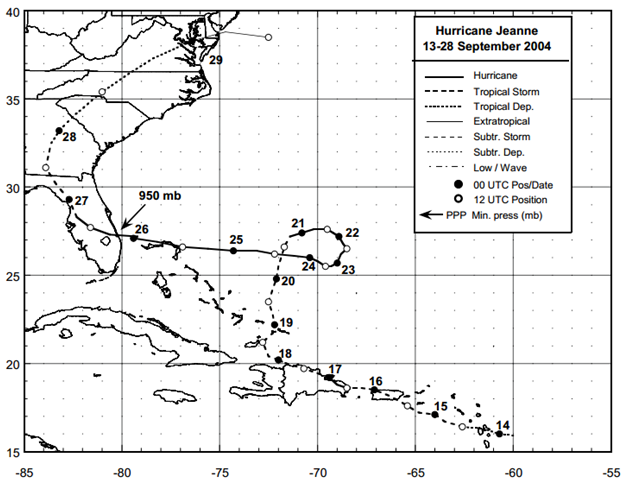Hurricane Jeanne occurred between 13 and 28 September 2004. It hit the central Florida east coast as a category three hurricane. Storm surge flooding of up to 6 feet above normal tides likely occurred along the Florida east coast from the vicinity of Melbourne southward to Ft. Pierce. Maximum sustained winds up to 79 knots were recorded during this Hurricane in the United States. There was a total of 4 fatalities in the United States with about $3.44 billion property damage [NOAA, 2005]1.

Figure: Best track positions for Hurricane Jeanne, 13-28 September 2004 (Source: NOAA1)
1Lawrence, M. B., and Cobb, H. D., (January 2005), Tropical Cyclone Report Hurricane Jeanne 13-28 September 2004, National Oceanic and Atmospheric Administration – National Hurricane Center.
Imagery
| File Name | Description | Source |
|---|---|---|
| Hurricane Jeanne Response Imagery Viewer | Hurricane Jeanne Response Images | NOAA - National Geodetic Survey - Emergency Response Imagery |
Miscellaneous
| File Name | Description | Source |
|---|---|---|
| Hurricane Jeanne 2004 | Including tropical cyclone report, aircraft missions, surface wind field analyses, satellite pictures, wind centers and tracks, radar composites, stepped frequency microwave radiometer, dropsonde data, and photos from flights | NOAA – Atlantic Oceanographic & Meteorological Laboratory |
Report
| File Name | Description | Source |
|---|---|---|
| Tropical Cyclone Report Hurricane Jeanne | The National Hurricane Center's Tropical Cyclone Reports (formerly called Preliminary Reports) contain comprehensive information on each storm, including synoptic history, meteorological statistics, casualties and damages, and the post-analysis best track (six-hourly positions and intensities). | NOAA – National Hurricane Center |
| Atlantic Hurricane Season of 2004 | The Hurricane Season summaries include descriptions of named storms along with pertinent meteorological data and satellite imagery. | NOAA – National Hurricane Center |
| FEMA 490, Mitigation Assessment Team Report: Summary Report on Building Performance 2004 Hurricane Season (2005) | The purpose of this document is to summarize the observations, conclusions, and recommendations that were obtained during post-disaster assessments sponsored by the FEMA Mitigation Division in response to Florida 2004 hurricane season. More than ten rapid response teams and two Mitigation Assessment Teams (MATs) were deployed to document observations and provide recommendations. The rapid response data collection teams focused on coastal high water marks, inland wind effects, residential and commercial building performance, critical and essential facility performance, and mitigation program effectiveness. The MATs assessed damage to the built environment and relied on the perishable data, such as high water marks, collected by the rapid response teams to quantify flood and wind effects of the hurricanes. | FEMA |

 Give to Florida Tech
Give to Florida Tech 